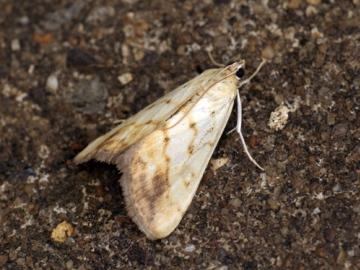Species Account for Evergestis extimalis
Evergestis extimalis (Scopoli, 1763) 63.058
Marbled Yellow Pearl
Lepidoptera: micromoths: Crambidae

Reproduction for study and non-profit use permitted, all other rights reserved.
Taxonomic group: micro moths (Lepidoptera: micromoths) - County data
View time series maps for Evergestis extimalis
member log-on for taxon report
Verification Grade:
Adult:
Adult: Distinctive
Essex RDB: Listed
Images
upload a new image
Evergestis extimalis on UK Moths website
Species text
Although undoubtedly resident, and recently recorded from twenty-three vice-counties, this species is probably only breeding in the Breckland and along the Thames estuary. The larva feeds on the seed-heads of Cruciferae, especially perennial wall-rocket Diplotaxis tenuifolia (Thames estuary), and charlock Sinapis arvensis and white mustard S. alba (Breckland), making a silken web in which several larvae may be found together. When full grown, the larva makes a tough cocoon in soil in which it hibernates, pupating in May. Much habitat has probably been lost through afforestation and development, such as housing and road building. Vegetation succession leading to a loss of bare disturbed ground and a loss of the species' ruderal foodplants may threaten this moth. Management should aim to maintain a varied vegetation, from open disturbed ground, which will help in encouraging a continuity of foodplant supply, through to taller grassy vegetation. On some Breckland sites rotovation may be considered. This should be undertaken on rotation involving only a small area of land in any one year (Parsons, 1993). References
Habitats
Why not join the Club, register and add a new species page
Interpretation of distribution maps





















